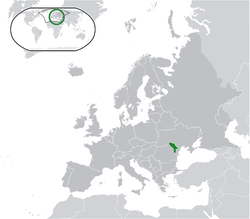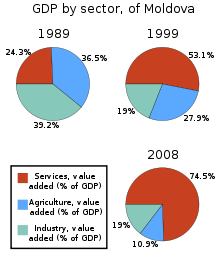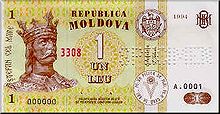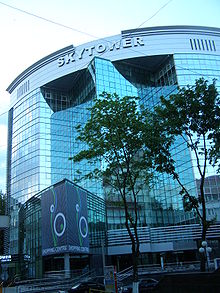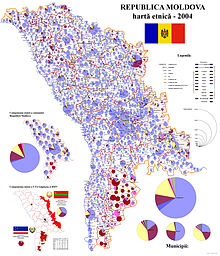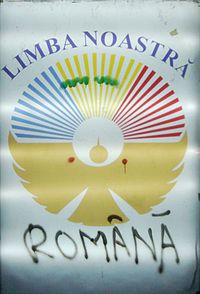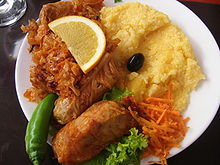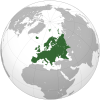- Moldova
-
This article is about the modern state. For the principality, see Moldavia. For other uses, see Moldova (disambiguation).
Republic of Moldova Republica Moldova

Flag Coat of arms Anthem: Limba Noastră
Our LanguageLocation of Moldova (green) – Transnistria (light green)
on the European continent (green + dark grey)Capital
(and largest city) Chişinău
Chişinău
47°0′N 28°55′E / 47°N 28.917°EOfficial language(s) Moldovan (Romanian)1 Recognised regional languages Gagauz, Russian and Ukrainian Ethnic groups (2004) 75.8% Moldovans2,
8.3% Ukrainians,
5.9% Russians,
4.4% Gagauzes,
2.2% Romanians2,
1.9% Bulgarians,
1.5% others and unspecified [1]
(excl. Transnistria)Demonym Moldovan, Moldavian Government Parliamentary republic - Acting President Marian Lupu - Prime Minister Vlad Filat - President of the Parliament Marian Lupu Consolidation - Declaration of Sovereignty June 23, 1990 - Declaration of Independence (from the Soviet Union)
August 27, 19913Area - Total 33,846 km2 (138th)
13,067 sq mi- Water (%) 1.4
(incl. Transnistria)Population - 2011 estimate 3,560,400[2] (129th3) - 2004 census  3,383,332[1]
3,383,332[1]
(excl. Transnistria)- Density 121.9/km2 (87th)
316/sq miGDP (PPP) 2010 estimate - Total $10.986 billion[3] - Per capita $3,082[3] GDP (nominal) 2010 estimate - Total $5.810 billion[3] - Per capita $1,630[3] Gini (2007) 37.1 (medium) HDI (2011)  0.649[4] (medium) (111th)
0.649[4] (medium) (111th)Currency Moldovan leu ( MDL)Time zone EET (UTC+2) - Summer (DST) EEST (UTC+3) Drives on the right ISO 3166 code MD Internet TLD .md Calling code 373 1 "Moldovan" used as formal official name; in fact Romanian.[5] 2 There is a controversy whether Moldovans and Romanians are the same of different ethnic groups. 3 Proclaimed. Finalized along with the dissolution of the USSR in December 1991. 4 Ranking based on 2009 UN figure. Moldova
 i/mɒlˈdoʊvə/, officially the Republic of Moldova (Moldovan/Romanian: Republica Moldova pronounced [reˈpublika molˈdova]) is a landlocked state in Eastern Europe, located between Romania to the West and Ukraine to the North, East and South. It declared itself an independent state with the same boundaries as the preceding Moldavian Soviet Socialist Republic in 1991, as part of the dissolution of the Soviet Union. A strip of Moldova's internationally recognized territory on the east bank of the river Dniester has been under the de facto control of the breakaway government of Transnistria since 1990.
i/mɒlˈdoʊvə/, officially the Republic of Moldova (Moldovan/Romanian: Republica Moldova pronounced [reˈpublika molˈdova]) is a landlocked state in Eastern Europe, located between Romania to the West and Ukraine to the North, East and South. It declared itself an independent state with the same boundaries as the preceding Moldavian Soviet Socialist Republic in 1991, as part of the dissolution of the Soviet Union. A strip of Moldova's internationally recognized territory on the east bank of the river Dniester has been under the de facto control of the breakaway government of Transnistria since 1990.The nation is a parliamentary republic with a president as head of state and a prime minister as head of government. Moldova is a member state of the United Nations, Council of Europe, WTO, OSCE, GUAM, CIS, BSEC and other international organizations. Moldova currently aspires to join the European Union,[6] and has implemented the first three-year Action Plan within the framework of the European Neighbourhood Policy (ENP).[7]
Contents
Etymology
Main article: Name of MoldovaThe name "Moldova" is derived from the Moldova River; the valley of this river was a political center when the Principality of Moldavia was founded in 1359.[8] The origin of the name of the river is not clear. There is an account (a legend) of prince Dragoş naming the river after hunting an aurochs: after the chase, his exhausted hound Molda drowned in the river. According to Dimitrie Cantemir and Grigore Ureche, the dog's name was given to the river and extended to the Principality.[9]
History
Main article: History of MoldovaPrehistory
During the Neolithic stone age era Moldova's territory was the center of the large Cucuteni-Trypillian culture that stretched east beyond the Dniester River in Ukraine, and west up to and beyond the Carpathian Mountains in Romania. The inhabitants of this civilization, which lasted roughly from 5500 to 2750 BC, practiced agriculture, raised livestock, hunted, and made intricately designed pottery.[10] This society built very large settlements, some of which numbered up to 15,000 inhabitants.[citation needed]
Antiquity and Middle Ages
In Antiquity Moldova's territory was inhabited by Dacian tribes. Between the I and VII centuries AD, the south was intermittently under the Roman, then Byzantine Empires. Due to its strategic location on a route between Asia and Europe, the territory of modern Moldova was invaded many times in late antiquity and early Middle Ages, including by Goths, Huns, Avars, Bulgarians, Magyars, Pechenegs, Cumans, Mongols and Tatars.
The Principality of Moldavia, established in 1359, was bounded by the Carpathian mountains in the west, Dniester river in the east, and Danube and Black Sea in the south. Its territory comprised the present-day territory of the Republic of Moldova, the eastern eight of the 41 counties of Romania, and the Chernivtsi oblast and Budjak region of Ukraine. Like the present-day republic and Romania's north-eastern region, it was known to the locals as Moldova. Moldavia was invaded repeatedly by Crimean Tatars and, since the 15th century, by the Turks. In 1538, the principality became a tributary to the Ottoman Empire, but it retained internal and partial external autonomy.[11]
Modern history
Russian Empire
In accordance with the Treaty of Bucharest of 1812 and despite numerous protests by Moldavian nobles on behalf of their autonomous status, the Ottoman Empire (of which Moldavia was a vassal) ceded to the Russian Empire the eastern half of the territory of the Principality of Moldavia along with Khotyn and old Bessarabia (modern Budjak).
The new Russian province was called "Oblast of Moldavia and Bessarabia", and initially enjoyed a large degree of autonomy. After 1828 this autonomy was progressively restricted and in 1871 the Oblast was transformed into the Bessarabia Governorate, in a process of state-imposed assimilation, "Russification". As part of this process, the Tsarist administration in Bessarabia gradually removed the Romanian language from official and religious use.[12] The western part of Moldavia (which is a part of present-day Romania) remained an autonomous principality, and in 1859, united with Wallachia to form the Kingdom of Romania.
The Treaty of Paris (1856) returned three counties of Bessarabia — Cahul, Bolgrad and Ismail — to Moldavia, but in the Treaty of Berlin (1878), the Kingdom of Romania agreed to return them to the Russian Empire. Over the 19th century, the Russian authorities encouraged colonization of the south of the region by Ukrainians, Lipovans, Cossacks, Bulgarians,[13] Germans,[14] Gagauzes, and allowed the settlement of more Jews,[15] to replace the large Nogai Tatar population expelled in the 1770s and 1780s, during Russo-Turkish Wars;[16] the Moldovan proportion of the population decreased from around 86% in 1816[17] to around 52% in 1905.[18]
Greater Romania
World War I brought in a rise in political and cultural (ethnic) awareness among the inhabitants of the region, as 300,000 Bessarabians were drafted into the Russian Army formed in 1917; within bigger units several "Moldavian Soldiers' Committees" were formed. Following the Russian Revolution of 1917, a Bessarabian parliament, Sfatul Ţării, was elected in October–November 1917 and opened on December 3 [O.S. November 21] 1917. The Sfatul Ţării proclaimed the Moldavian Democratic Republic (December 15 [O.S. December 2] 1917) within a federal Russian state, and formed a government (December 21 [O.S. December 8] 1917).
Bessarabia proclaimed independence from Russia on February 6 [O.S. January 24] 1918 and requested the assistance of the French army present in Romania (general Henri Berthelot) and of the Romanian army, which had occupied the region in early January.[19] On April 9 [O.S. March 27] 1918, the Sfatul Ţării decided with 86 votes for, 3 against and 36 abstaining, to unite with the Kingdom of Romania. The union was conditional upon fulfillment of the agrarian reform, autonomy, and respect for universal human rights.[20] A part of the interim Parliament agreed to drop these conditions after Bukovina and Transylvania also joined the Kingdom of Romania, although historians note that they lacked the quorum to do so.[21][22][23][24][25]
This union was recognized by the principal Allied Powers in the 1920 Treaty of Paris, which however was not ratified by all of its signatories.[26][27] Some major powers, such as the United States and the newly communist Russia, did not recognize Romanian rule over Bessarabia, the latter considering it an occupation of Russian territory.[28]
In May 1919, the Bessarabian Soviet Socialist Republic was proclaimed as a government in exile. After the failure of the Tatarbunary Uprising in 1924, the Moldavian Autonomous Soviet Socialist Republic (Moldavian ASSR) was formed.
In August 1939, the Molotov-Ribbentrop Pact and its secret additional protocol were signed, by which Nazi Germany recognized Bessarabia as being within the Soviet sphere of influence, which led the latter to actively revive its claim to the region.[29] On June 28, 1940, the Soviet Union, with the acknowledgement of Nazi Germany, issued an ultimatum to Romania requesting the cession of Bessarabia and northern Bukovina, with which Romania complied the following day. Soon after, the Moldavian Soviet Socialist Republic (Moldavian SSR) was established,[29] comprising about 70% of Bessarabia, and 50% of the now-disbanded Moldavian ASSR.
As part of the 1941 Axis invasion of the Soviet Union, Romania seized the territories of Bessarabia, northern Bukovina, and Transnistria. Romanian forces, working with the Germans, deported or exterminated about 300,000 Jews, including 147,000 from Bessarabia and Bukovina (of the latter, approximately 90,000 perished).[30] The Soviet Army re-captured the region in February–August 1944, and re-established the Moldavian SSR. Between the end of the Jassy-Kishinev Offensive in August 1944 and the end of the war in May 1945, 256,800 inhabitants of the Moldavian SSR were drafted into the Soviet Army. 40,592 of them perished.[31]
Soviet era
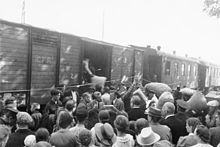 Ethnic Germans resettling after the Soviet occupation of Bessarabia in 1940
Ethnic Germans resettling after the Soviet occupation of Bessarabia in 1940
During the Stalinist period (1940–1941, 1944–1953), deportations of locals to the northern Urals, to Siberia, and northern Kazakhstan occurred regularly, with the largest ones on 12–13 June 1941, and 5–6 July 1949, accounting from MSSR alone for 18,392[32] and 35,796 deportees respectively.[33] Other forms of Soviet persecution of the population included 32,433 political arrests, followed by Gulag or (in 8,360 cases) execution.
In 1946, as a result of a severe drought and excessive delivery quota obligations and requisitions imposed by the Soviet government, the southwestern part of the USSR suffered from a major famine.[34] In 1946–1947, at least 216,000 deaths and about 350,000 cases of dystrophy were accounted by historians in the Moldavian SSR alone.[33] Similar events occurred in 1930s in the Moldavian ASSR.[33] In 1944–53, there were several anti-Soviet resistance groups in Moldova; however the NKVD and later MGB managed to eventually arrest, execute or deport their members.[33]
In the postwar period, the Soviet government arranged migration of workforce (mostly Russians, Belarusians, and Ukrainians), into the new Soviet republic, especially into urbanized areas, partly to compensate for the demographic loss caused by the war and the emigration of 1940 and 1944.[35] In the 1970s and 1980s, the Moldavian SSR received substantial allocations from the budget of the USSR to develop industrial and scientific facilities and housing. In 1971, the Council of Ministers of the USSR adopted a decision "About the measures for further development of the city of Kishinev" (modern Chişinău), that allotted more than one billion Soviet rubles from the USSR budget for building projects,[36] subsequent decisions also directed substantial funding and brought qualified specialists from other parts of the USSR to develop Moldova's industry.
The Soviet government conducted a campaign to promote a Moldovan ethnic identity distinct from that of the Romanians, based on a theory developed during the existence of the Moldavian ASSR. Official Soviet policy asserted that the language spoken by Moldovans was distinct from the Romanian language (see Moldovenism). To distinguish the two, during the Soviet period, Moldovan was written in the Cyrillic alphabet, in contrast[citation needed] with Romanian, which since 1860 had been written in the Latin alphabet.
After the death of Stalin, political persecutions changed in character from mass to individual. All independent organizations were severely reprimanded, with the National Patriotic Front leaders being sentenced in 1972 to long prison terms. The Commission for the Study of the Communist Dictatorship in Moldova is assessing the activity of the communist totalitarian regime.
In the 1980s, political conditions created by the glasnost and perestroika, a Democratic Movement of Moldova was formed, which in 1989 became known as the nationalist Popular Front of Moldova (FPM).[37][38] Along with several other Soviet republics, from 1988 onwards, Moldova started to move towards independence. On August 27, 1989, the FPM organized a mass demonstration in Chişinău that became known as the Grand National Assembly. The assembly pressured the authorities of the Moldavian SSR to adopt a language law on August 31, 1989 that proclaimed the Moldovan language written in the Latin script to be the state language of the MSSR. Its identity with the Romanian language was also established.[37][39]
Independence
 Deputy Gheorghe Ghimpu replaces the Soviet flag on the Parliament with the national one on April 27, 1990
Deputy Gheorghe Ghimpu replaces the Soviet flag on the Parliament with the national one on April 27, 1990
The first democratic elections for the local parliament were held in February and March 1990. Mircea Snegur was elected as Speaker of the Parliament, and Mircea Druc as Prime Minister. On June 23, 1990, the Parliament adopted the Declaration of Sovereignty of the "Soviet Socialist Republic Moldova", which, among other things, stipulated the supremacy of Moldovan laws over those of the Soviet Union.[37] After the failure of the 1991 Soviet coup d'état attempt, on August 27, 1991, Moldova declared its independence, Romania being the first state to recognize its independence.
On December 21 of the same year Moldova, along with most of the other Soviet republics, signed the constitutive act that formed the post-Soviet Commonwealth of Independent States (CIS). Moldova received official recognition on December 25. On December 26, 1991 the Soviet Union ceased to exist. Declaring itself a neutral state, it did not join the military branch of the CIS. Three months later, on March 2, 1992, the country gained formal recognition as an independent state at the United Nations. In 1994, Moldova became a member of NATO's Partnership for Peace program and also a member of the Council of Europe on June 29, 1995.[37]
In the region east of the Dniester river, Transnistria, which includes a large proportion of predominantly russophone East Slavs of Ukrainian (28%) and Russian (26%) descent (altogether 54% as of 1989), while Moldovans (40%) have been the largest ethnic group, and where the headquarters and many units of the Soviet 14th Guards Army were stationed, an independent Pridnestrovian Moldavian Soviet Socialist Republic was proclaimed on August 16, 1990, with its capital in Tiraspol.[37] The motives behind this move were fear of the rise of nationalism in Moldova and the country's expected reunification with Romania upon secession from the USSR. In the winter of 1991–1992 clashes occurred between Transnistrian forces, supported by elements of the 14th Army, and the Moldovan police. Between March 2 and July 26, 1992, the conflict escalated into a military engagement.
On January 2, 1992, Moldova introduced a market economy, liberalizing prices, which resulted in rapid inflation. From 1992 to 2001, the young country suffered a serious economic crisis, leaving most of the population below the poverty line. In 1993, a national currency, the Moldovan leu, was introduced to replace the temporary cupon. The economy of Moldova began to change in 2001; and until 2008 the country saw a steady annual growth of between 5% and 10%. The early 2000s also saw a considerable growth of emigration of Moldovans looking for work (mostly illegally) in Russia (especially the Moscow region), Italy, Portugal, Spain, Greece, Cyprus, Turkey, and other countries; remittances from Moldovans abroad account for almost 38% of Moldova's GDP, the second-highest percentage in the world.[40]
In the 1994 parliamentary elections, the Democratic Agrarian Party gained a majority of the seats, setting a turning point in Moldovan politics. With the nationalist Popular Front now in a parliamentary minority, new measures aiming to moderate the ethnic tensions in the country could be adopted. Plans for a union with Romania were abandoned,[37] and the new Constitution gave autonomy to the breakaway Transnistria and Gagauzia. On December 23, 1994, the Parliament of Moldova adopted a "Law on the Special Legal Status of Gagauzia", and in 1995 the latter was constituted.
After winning the 1996 presidential elections, on January 15, 1997, Petru Lucinschi, the former First Secretary of the Moldavian Communist Party in 1989–91, became the country's second president (1997–2001), succeeding Mircea Snegur (1991–1996). In 2000, the Constitution was amended, transforming Moldova into a parliamentary republic, with the president being chosen through indirect election rather than direct popular vote.
Winning 49.9% of the vote, the Party of Communists of the Republic of Moldova (reinstituted in 1993 after being outlawed in 1991), gained 71 of the 101 MPs, and on April 4, 2001, elected Vladimir Voronin as the country's third president (re-elected in 2005). The country became the first post-Soviet state where a non-reformed Communist Party returned to power.[37] New governments were formed by Vasile Tarlev (April 19, 2001 – March 31, 2008), and Zinaida Greceanîi (March 31, 2008 – September 14, 2009). In 2001–2003 relations between Moldova and Russia improved, but then temporarily deteriorated in 2003–2006, in the wake of the failure of the Kozak memorandum, culminating in the 2006 wine exports crisis. The Party of Communists of the Republic of Moldova managed to stay in power for eight years, mainly due to the appeal to the ethnic minorities, the support from the West during the presidential elections from April 4, 2005, the reliance on the Soviet notion of the Moldovan identity, the attempts to build a state based only on the Moldovan identity, and most important due to the control over a significant portion of the Moldovan media. The fragmentation of the liberal (aka the democrats) and the frequent manipulations of the electoral laws helped consolidate its power. The decline of the party started in 2009 after Marian Lupu joined the Democratic Party and thus attracted many of the Moldovans supporting the Communists.[41]
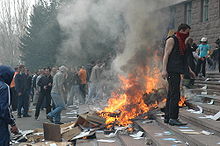 2009 Moldova civil unrest at the Parliament building
2009 Moldova civil unrest at the Parliament building
In the April 2009 parliamentary elections, the Communist Party won 49.48% of the votes, followed by the Liberal Party with 13.14% of the votes, the Liberal Democratic Party with 12.43%, and the Alliance "Moldova Noastră" with 9.77%. The controversial results of this election sparked civil unrest[42][43]
In August 2009, four Moldovan parties – Liberal Democratic Party, Liberal Party, Democratic Party, and Our Moldova Alliance – agreed to create a governing coalition that pushed the Communist party into opposition. On August 28, 2009, this coalition chose a new parliament speaker (Mihai Ghimpu) in a vote that was boycotted by Communist legislators. Vladimir Voronin, who had been President of Moldova since 2001, eventually resigned on September 11, 2009, but the Parliament failed to elect a new president. The acting president Mihai Ghimpu instituted the Commission for constitutional reform in Moldova to adopt a new version of the Constitution of Moldova. After the constitutional referendum aimed to approve the reform failed in September 2010,[44] the parliament was dissolved again and a new parliamentary election was scheduled for 28 November 2010.[45] On December 30, 2010, Marian Lupu was elected as the Speaker of the Parliament.[46] In accordance with the Constitution, he will be serving as the Acting President of Republic of Moldova.
Elections in Moldova since 1917 Election Parties and parliamentary seats President of Parliament Prime minister President 1917 See Sfatul Ţării and Moldavian Democratic Republic Ion Inculeţ Erhan, Ciugureanu, Cazacu Ion Inculeţ 1940-1984 Communist Party 100% Brovko, Codiţă, Iliaşenco, Călin,
Mocanu, Ciobanu, SnegurKonstantinov, Coval, Rudi, Diordiţă,
Pascari, Grossu, Ustian, Călin- 1990 Popular Front, Communist Party Snegur, Moşanu Druc, Muravschi, Andrei Sangheli Mircea Snegur 1994 PDAM 56, BePSMUE 28, BTI 11, BeAFPCD 9 Lucinschi, Moţpan Sangheli, Ciubuc Snegur, Lucinschi 1998 PCRM 40, BECD 26, PMDM 24, PFD 11 Dumitru Diacov Ciubuc, Sturza, Braghiş Petru Lucinschi 2001 PCRM 70, Braghiş Alliance 19, PPCD 11 Eugenia Ostapciuc Vasile Tarlev Vladimir Voronin 2005 PCRM 56, BEMD 34 (AMN 22, PDM 8, PSL 4), PPCD 11 Marian Lupu Vasile Tarlev, Zinaida Greceanîi Vladimir Voronin 2009 (April) PCRM 60, PL 15, PLDM 15, AMN 11 Kalin, Voronin Zinaida Greceanîi Vladimir Voronin 2009 (July) PCRM 48, AIE 53 (PLDM 18, PL 15, PDM 13, AMN 7) Mihai Ghimpu Filat Ghimpu (acting) 2010 (November) PCRM 42, PLDM 32, PDM 15, PL 12 Marian Lupu Filat Marian Lupu (acting) Government and politics
Main articles: Politics of Moldova and Human rights in MoldovaMoldova 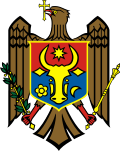
This article is part of the series:
Politics and government of
MoldovaConstitutionParliamentJudiciaryExecutiveDivisionsElectionsForeign policy
Moldova is a unitary parliamentary representative democratic republic. The 1994 Constitution of Moldova sets the framework for the government of the country. A parliamentary majority of at least two thirds is required to amend the Constitution of Moldova, which cannot be revised in time of war or national emergency. Amendments to the Constitution affecting the state's sovereignty, independence, or unity can only be made after a majority of voters support the proposal in a referendum. Furthermore, no revision can be made to limit the fundamental rights of people enumerated in the Constitution.[47]
The country's central legislative body is the unicameral Moldovan Parliament (Parlament), which has 101 seats, and whose members are elected by popular vote on party lists every four years.
The head of state is the President of Moldova, who is elected by the Moldovan Parliament, requiring the support of three fifths of the deputies (at least 61 votes). The president of Moldova has been elected by the parliament since 2001, a change designed to decrease executive authority in favor of the legislature. The president appoints a prime minister who functions as the head of government, and who in turn assembles a cabinet, both subject to parliamentary approval.
The 1994 constitution also establishes an independent Constitutional Court, composed of six judges (two appointed by the President, two by Parliament, and two by the Supreme Council of Magistrature), serving six-year terms, during which they are irremovable and not subordinate to any power. The Court is invested with the power of judicial review over all acts of the parliament, over presidential decrees, and over international treaties, signed by the country.[47]
Political forces Seats Moldovan Parliament seats after 2010 polls Alliance for European Integration 59 Party of Communists 42 PCRM (42) · PLDM (32) · PDM (15) · PL (12) Foreign relations
Main articles: Foreign Relations of Moldova and Moldova and the European UnionAfter achieving independence from the Soviet Union, Moldova established relations with other European countries. A course for European Union integration and neutrality define the country's foreign policy guidelines. In 1995 the country was admitted to the Council of Europe. In addition to its participation in NATO's Partnership for Peace program, Moldova is also a member state of the United Nations, the OSCE, the North Atlantic Cooperation Council, the World Trade Organization, the International Monetary Fund, the World Bank, the Francophonie and the European Bank for Reconstruction and Development.
In 2005, Moldova and the EU established an action plan that sought to improve the collaboration between the two neighboring structures. At the end of 2005 EUBAM, the European Union Border Assistance Mission to Moldova and Ukraine, was established at the joint request of the presidents of Moldova and Ukraine. EUBAM assists the Moldovan and Ukrainian governments in approximating their border and customs procedures to EU standards, and offers support in both countries' fight against cross-border crime. www.eubam.org
After the War of Transnistria, Moldova sought a peaceful resolution to the conflict in the Transnistria region by working with Romania, Ukraine, and Russia, calling for international mediation, and cooperating with the OSCE and UN fact-finding and observer missions. The foreign minister of Moldova, Andrei Stratan, repeatedly stated that the Russian troops stationed in the breakaway region are there against the will of the Moldovan Government and called on them to leave "completely and unconditionally."[48]
In September 2010, the European Parliament approved a grant of €90 million to Moldova.[49] The money will supplement $570 million in International Monetary Fund loans,[50] World Bank and other bilateral support already granted to Moldova. In April 2010, Romania offered to Moldova development aid worth of €100 million while the number of scholarships for Moldovan students will double to 5,000[51] According to a lending agreement signed in February 2010, Poland will provide US$15 million and will support Moldova in its European integration efforts.[52]
Military
 Soldiers of Moldova army
Soldiers of Moldova army Main article: Military of Moldova
Main article: Military of MoldovaThe Moldovan armed forces consist of the Ground Forces and Air and Air Defense Forces. Moldova has accepted all relevant arms control obligations of the former Soviet Union. On October 30, 1992, Moldova ratified the Treaty on Conventional Armed Forces in Europe, which establishes comprehensive limits on key categories of conventional military equipment and provides for the destruction of weapons in excess of those limits. The country acceded to the provisions of the nuclear Non-Proliferation Treaty in October 1994 in Washington, D.C. It does not have nuclear, biological, or chemical weapons. Moldova joined the North Atlantic Treaty Organisation's Partnership for Peace on March 16, 1994.
Moldova is committed to a number of international and regional control of arms regulations such as the UN Firearms Protocol, Stability Pact Regional Implementation Plan, the UN Programme of Action (PoA) and the OSCE Documents on Stockpiles of Conventional Ammunition.
Administrative divisions
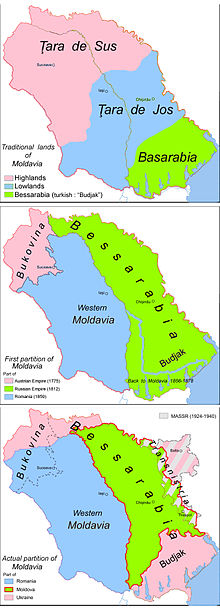 Territories of the medieval Principality of Moldavia are now split between Romania in blue, Moldova in green, and Ukraine in pink (Chernivtsi oblast and Budjak).
Territories of the medieval Principality of Moldavia are now split between Romania in blue, Moldova in green, and Ukraine in pink (Chernivtsi oblast and Budjak). Main articles: Administrative divisions of Moldova, List of cities in Moldova, and List of localities in Moldova
Main articles: Administrative divisions of Moldova, List of cities in Moldova, and List of localities in MoldovaMoldova is divided into thirty-two districts (raioane, singular raion), three municipalities and two autonomous regions (Gagauzia and Transnistria).[53] The final status of Transnistria is disputed, as the central government does not control that territory. The cities of Comrat and Tiraspol, the administrative seats of the two autonomous territories also have municipality status.
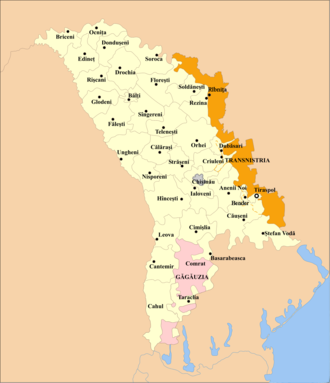
Municipalities Autonomous regions Chişinău
Bălţi
BenderGagauzia
TransnistriaDistricts Moldova has 65 cities (towns), including the five with municipality status, and 917 communes. Some other 699 villages are too small to have a separate administration, and are administratively part of either cities (40 of them) or communes (659). This makes for a total of 1,681 localities of Moldova, all but two of which are inhabited.
Largest cities of Moldova
Rank City Urban Rank City Urban 1 Chişinău1 664,700 (2011) 11 Comrat3 25,300 (2011) 2 Tiraspol2 148,900 (2011) 12 Ceadîr-Lunga3 22,800 (2011) 3 Bălţi1 144,000 (2011) 13 Drochia3 20,400 (2011) 4 Bender2 93,700 (2011) 14 Străşeni3 20,300 (2011) 5 Rîbniţa2 50,100 (2011) 15 Căuşeni3 20,000 (2011) 6 Cahul3 39,700 (2011) 16 Edineţ3 18,400 (2011) 7 Ungheni3 38,100 (2011) 17 Durleşti 18,400 (2011) 8 Soroca3 37,400 (2011) 18 Hînceşti 16,800 (2011) 9 Orhei3 33,500 (2011) 19 Faleşti 16,800 (2011) 10 Dubăsari3 25,700 (2011) 20 Vulcăneşti 16,600 (2011) Source: Moldovan Census (2004); Note: 1.World Gazetteer. Moldova: largest cities 2004. 2.Pridnestrovie.net 2004 Census 2004. 3. National Bureau of Statistics of Moldova Geography
Main article: Geography of Moldova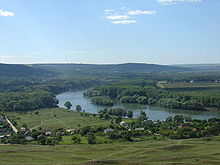 Dniester valley view
Dniester valley view
Moldova lies between latitudes 45° and 49° N, and mostly between meridians 26° and 30° E (a small area lies east of 30°).
The largest part of the nation lies between two rivers, the Dniester and the Prut. The western border of Moldova is formed by the Prut river, which joins the Danube before flowing into the Black Sea. Moldova has access to the Danube for only about 480 m (1,575 ft), and Giurgiuleşti is the only Moldovan port on the Danube. In the east, the Dniester is the main river, flowing through the country from north to south, receiving the waters of Răut, Bâc, Ichel, Botna. Ialpug flows into one of the Danube limans, while Cogâlnic into the Black Sea chain of limans.
The country is landlocked, even though it is very close to the Black Sea. While most of the country is hilly, elevations never exceed 430 m (1,411 ft) — the highest point being the Bălăneşti Hill. Moldova's hills are part of the Moldavian Plateau, which geologically originate from the Carpathian Mountains. Its subdivisions in Moldova include Dniester Hills (Northern Moldavian Hills and Dniester Ridge), Moldavian Plain (Middle Prut Valley and Bălţi Steppe), and Central Moldavian Plateau (Ciuluc-Soloneţ Hills, Corneşti Hills (Codri Massive; "Codri" meaning "forests"), Lower Dniester Hills, Lower Prut Valley, and Tigheci Hills). In the south, the country has a small flatland, the Bugeac Plain. The territory of Moldova east of the river Dniester is split between parts of the Podolian Plateau, and parts of the Eurasian Steppe.
The country's main cities are the capital Chişinău, in the center of the country, Tiraspol (in the eastern region of Transnistria), Bălţi (in the north) and Bender (in the south-east). Comrat is the administrative center of Gagauzia.
Panorama of the museum complex Old Orhei, a system of historical monuments and natural landscapes, famous for its cave monasteries.
Economy
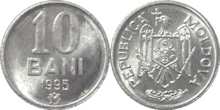 There are 1, 5, 10, 25, and 50 bani coins
There are 1, 5, 10, 25, and 50 bani coins Main article: Economy of Moldova
Main article: Economy of MoldovaSince the collapse of the Soviet Union, the relative weight of service sector in economy of Moldova started to grow and began to dominate the GDP (now about 75%), as a result of decrease in industry and agriculture. The main economical indicators contracted dramatically.
As of 2009[update], Moldova has been described by the European Parliament as the poorest country in Europe in terms of GDP.[54]
Energy
Moldova imports all of its supplies of petroleum, coal, and natural gas, largely from Russia. Moldova is a partner country of the EU INOGATE energy programme, which has four key topics: enhancing energy security, convergence of member state energy markets on the basis of EU internal energy market principles, supporting sustainable energy development, and attracting investment for energy projects of common and regional interest.[55]
Economic reforms
After the breakup of the Soviet Union in 1991, energy shortages contributed to sharp production declines. As part of an ambitious economic liberalization effort, Moldova introduced a convertible currency, liberalized all prices, stopped issuing preferential credits to state enterprises, backed steady land privatization, removed export controls, and liberalized interest rates. The government entered into agreements with the World Bank and the International Monetary Fund to promote growth.
Recent trends indicate that the Communist government intends to reverse some of these policies, and recollectivise land while placing more restrictions on private business. The economy returned to positive growth, of 2.1% in 2000 and 6.1% in 2001. Growth remained strong in 2007 (6%), in part because of the reforms and because of starting from a small base. The economy remains vulnerable to higher fuel prices, poor agricultural weather, and the skepticism of foreign investors.[citation needed]
Following the regional financial crisis in 1998, Moldova has made significant progress towards achieving and retaining macroeconomic and financial stabilization. It has, furthermore, implemented many structural and institutional reforms that are indispensable for the efficient functioning of a market economy. These efforts have helped maintain macroeconomic and financial stability under difficult external circumstances, enabled the resumption of economic growth and contributed to establishing an environment conducive to the economy's further growth and development in the medium term.[citation needed]
Despite these efforts and recent resumption of economic growth, Moldova ranks low in terms of commonly used living standards and human development indicators in comparison with other transition economies. Although the economy experienced a constant economic growth after 2000: with 2.1%, 6.1%, 7.8% and 6.3% between 2000 and 2003 (with a forecast of 8% in 2004), one can observe that these latest developments hardly reach the level of 1994, with almost 40% of the GDP registered in 1990. Thus, during the last decade little has been done to reduce the country's vulnerability. After a severe economic decline, social and economic challenges, energy uprooted dependencies, Moldova continues to occupy one of the last places among European countries in income per capita.[citation needed]
In 2005 (according to the Human Development Report), the registered GDP per capita was US $ 2,100 PPP, which was 4.5 times lower than the world average at the time (US $ 9,543). Moreover, GDP per capita was under the average of its statistical region (US $ 9,527 PPP). In 2005, about 20.8% of the population were under the absolute poverty line and registered an income lower than US $ 2.15 (PPP) per day. Moldova is classified as medium in human development and is at the 111th spot in the list of 177 countries. The value of the Human Development Index (0.708) is below the world average. Moldova remains the poorest country in Europe in terms of official (i.e., excluding the black and grey economy) per capita which currently stands at $1,808.729[56]
The GDP in 2007 constituted $4.104 billion.[57] That constituted a growth of 3% from 2006.
Wine industry
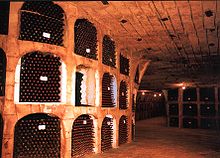 Mileştii Mici contains the world's largest wine cellars
Mileştii Mici contains the world's largest wine cellars Main articles: Moldovan wine and Moldovan wine producers
Main articles: Moldovan wine and Moldovan wine producersMoldova is known for its wines. For many years viticulture and winemaking in Moldova were the general occupation of the population. Evidence of this is present in historical memorials and documents, folklore, and the Moldovan spoken language.
The country has a well established wine industry. It has a vineyard area of 147,000 hectares (360,000 acres), of which 102,500 ha (253,000 acres) are used for commercial production. Most of the country's wine production is made for export. Many families have their own recipes and strands of grapes that have been passed down through the generations.
Moldova consumes the highest amount of alcohol per capita in the world.[58]
Agriculture
Main article: Agriculture of MoldovaMoldova's rich soil and temperate continental climate (with warm summers and mild winters) have made the country one of the most productive agricultural regions since ancient times, and a major supplier of agricultural products in southeastern Europe. In agriculture, the economic reform started with the land cadastre reform.
Tourism
Main article: Tourism in MoldovaTourism focuses on the country's natural landscapes and its history. Wine tours are offered to tourists across the country. Vineyards/cellars include Cricova, Purcari, Ciumai, Romanesti, Cojuşna, Milestii Mici.
Transport
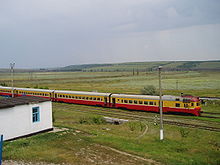 A train in Moldova
A train in Moldova Main articles: Transport in Moldova and Rail transport in Moldova
Main articles: Transport in Moldova and Rail transport in MoldovaThe main means of transportation in Moldova are railroads 1,138 km (707 mi) and a highway system (12,730 km/7,910 mi overall, including 10,937 km/6,796 mi of paved surfaces). The sole international air gateway of Moldova is the Chişinău International Airport. The Giurgiuleşti terminal on the Danube is compatible with small seagoing vessels. Shipping on the lower Prut and Nistru rivers plays only a modest role in the country's transportation system.
Telecommunications
Main article: Telecommunications in MoldovaThe first million of mobile telephone users was registered in September 2005. The number of mobile telephone users in Moldova increased by 47.3 % in the first quarter of 2008 against the last year and exceeded 2.89 million.[59]
In September 2009, Moldova was the first country in the world to launch high-definition voice services (HD voice) for mobile phones, and the first country in Europe to launch 14,4 Mbit/s mobile broadband at a national scale, with over 40% population coverage.[60]
As of 2010[update] there are around 1,295,000 Internet users in Moldova with overall Internet penetration of 35.9%.[61]
Demographics
Main article: Demographics of MoldovaCultural and ethnic composition
The last reference data is that of the 2004 Moldovan Census[1] (areas controlled by the central government), and the 2004 Census in Transnistria (areas controlled by the breakaway authorities, including Transnistria, Bender/Tighina, and four neighboring communes):
Self-identification Moldovan
census% Core
MoldovaTransnistrian
census% Transnistria
+ BenderTotal % Moldovans1 2,564,849 75.81% 177,382 31.94% 2,742,231 69.62% Ukrainians 282,406 8.35% 160,069 28.82% 442,475 11.23% Russians 201,218 5.95% 168,678 30.37% 369,896 9.39% Gagauz 147,500 4.36% 4,096 0.74% 151,596 3.85% Romanians1 73,276 2.17% 253 0.05% 73,529 1.87% Bulgarians 65,662 1.94% 13,858 2.50% 79,520 2.02% Romani 12,271 0.36% 507 0.09% 12,778 0.32% Jews 3,608 0.11% 1,259 0.23% 4,867 0.12% Poles 2,383 0.07% 1,791 0.32% 4,174 0.11% Others/undeclared 30,159 0.89% 27,454 4.94% 57,613 1.46% TOTAL 3,383,332 100% 555,347 100% 3,938,679 100% 1There is an ongoing controversy over:
- whether the Moldavians from Romanian Moldavia are also ethnic Moldovans;
- whether Romanians and Moldovans are the same ethnic group, namely whether Moldovans' self-identification constitutes an ethnic group distinct and apart from Romanians or a subset. At the census, citizens could declare only one nationality. Consequently, one could not declare oneself both Moldovan and Romanian.
Languages
Main articles: Languages of Moldova, Moldovan language, and Romanian languageThe Constitution of 1994 states that the national language of the Republic of Moldova is Moldovan, and its writing is based on the Latin alphabet.[62] The 1991 Declaration of Independence names the official language Romanian.[63][64] The 1989 State Language Law speaks of a Moldovan-Romanian linguistic identity.
There is a political controversy over the name of the main ethnicity of the Republic of Moldova. During 2003–2009, the Communist government adopted a national political conception which states that one of the priorities of the national politics of the Republic of Moldova is the insurance of the existence of the Moldovan language.[65][66] Scholars agree that Moldovan and Romanian are the same language, with the glottonym "Moldovan" used in certain political contexts.[67]
Russian is provided with the status of a "language of interethnic communication" (alongside the official language), and in practice remains widely used on all levels of the society and the state. The above-mentioned national political conception also states that Russian-Moldovan bilingualism is characteristic for Moldova.[66]
As of the 2004 census, the country has significant Russian (6%) and Ukrainian (8.4%) populations. 50% of ethnic Ukrainians, 27% of Gagauz, 35% of Bulgarians, and 54% of smaller ethnic groups speak Russian as first language. In total, there are 541,000 people (or 16% of the population) in Moldova who use Russian as first language, including 130,000 ethnic Moldovans. By contrast, only 47,000 members of ethnic minorities use Romanian as first language.
Gagauz and Ukrainian have significant regional speaker populations and are granted official status together with Russian in Gagauzia and Transnistria respectively.
Population of Moldova Moldovan (Romanian) Russian Ukrainian Gagauz Bulgarian Other languages,
non-declaredby native language 2,588,355
76.51%380,796
11.26%186,394
5.51%137,774
4.07%54,401
1.61%35,612
1.04%by language of first use 2,543,354
75.17%540,990
15.99%130,114
3.85%104,890
3.10%38,565
1.14%25,419
0.75%From 1996 the Republic, also being Romance-speaking, is a full member of Francophonia. Therefore the French language occupies the principal place among the foreign languages. In 2009/10 it was told taught to 52% of schoolchildren as L1 and 7% as L2. It is followed by English having 48% and 6% respectively, and German, which was taught to 3% altogether.[68]
Religion
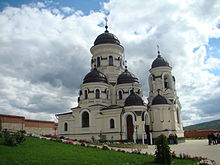 Căpriana, one of the oldest monasteries in Moldavia
Căpriana, one of the oldest monasteries in Moldavia Main article: Religion in Moldova
Main article: Religion in MoldovaFor the 2004 census, Orthodox Christians, who make up 93.3% of Moldova's population, were not required to declare the particular of the two main churches they belong to. The Moldovan Orthodox Church, autonomous and subordinated to the Russian Orthodox Church, and the Orthodox Church of Bessarabia, autonomous and subordinated to the Romanian Orthodox Church, both claim to be the national church of the country. 2% of the population is Protestant, 1.2% belongs to other religions, 0.9% is non-religious, 0.4% is atheist, and 2.2% did not answer the religion question at the census.
Education
Main article: Education in MoldovaIn Moldova, there are 16 state and 15[69] private institutions of higher education, with a total of 126,100 students, including 104,300 in the state institutions, and 21,700 in the private ones. The number of students per 10,000 inhabitants in Moldova has been constantly growing since the collapse of the Soviet Union, reaching 217 in 2000–2001, and 351 in 2005–2006.
The National Library of Moldova was founded in 1832. The Moldova State University and the Academy of Sciences of Moldova, the main scientific organizations of Moldova, were established in 1946.
Crime
Main article: Crime in MoldovaThe CIA World Factbook lists widespread crime and underground economic activity among major crime issues in Moldova.[70]
Health
Main article: Health in MoldovaThe average birth rate is at 1.5 children per woman.[71] Public expenditure on health was 4.2% of the GDP and private expenditure on health 3.2%.[71] There are about 264 physicians per 100,000 people.[71] Health expenditure was 138 US$ (PPP) per capita in 2004.[71]
Since the breakup of the Soviet Union, the country has seen a decrease in spending on health care and, as a result, the tuberculosis incidence rate in the country has grown.[72] Because of this, Moldova is struggling with one of the highest incidence rates of multidrug-resistant tuberculosis in the world.[73]
Emigration
Main article: Emigration from MoldovaEmigration is a mass phenomenon in Moldova and has a major impact on the country's demographics and economy. The Moldovan Intelligence and Security Service has estimated that 600,000 to one million Moldovan citizens (almost 25% of the population) are working abroad, most illegally.[74]
Culture
Main article: Culture of Moldova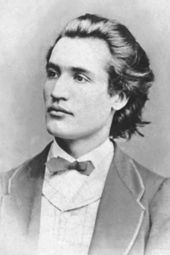 Mihai Eminescu, national poet of Moldova and Romania
Mihai Eminescu, national poet of Moldova and Romania
Located geographically at the crossroads of Latin, Slavic and other cultures, Moldova has enriched its own culture adopting and maintaining some of the traditions of its neighbors and of other influence sources.
The country's cultural heritage was marked by numerous churches and monasteries built by the Moldavian ruler Stephen the Great in the 15th century, by the works of the later renaissance Metropolitans Varlaam and Dosoftei, and those of scholars such as Grigore Ureche, Miron Costin, Nicolae Milescu, Dimitrie Cantemir,[75] Ion Neculce. In the 19th century, Moldavians from the territories of the medieval Principality of Moldavia, then split between Austria, Russia, and an Ottoman-vassal Moldavia (after 1859, Romania), made a significant contribution to the formation of the modern Romanian culture. Among these were many Bessarabians, such as Alexandru Donici, Alexandru Hâjdeu, Bogdan Petriceicu Hasdeu, Constantin Stamati, Constantin Stamati-Ciurea, Costache Negruzzi, Alecu Russo, Constantin Stere.
Mihai Eminescu, a late Romantic poet, and Ion Creangă, a writer, are the most influential Romanian language artists, considered national writers both in Romania and Moldova.[citation needed]
The largest ethnic group is a speaker of Romanian and share the Romanian culture. Their culture has been also influenced (through Eastern Orthodoxy) by the Byzantine culture.[citation needed]
The country has also important minority ethnic communities. Gagauz, 4.4% of the population, are Christian Turkic people. Greeks, Armenians, Poles, Jews, Ukrainians, although not numerous, were present since as early as 17th century, and had left cultural marks. The 19th century saw the arrival of many more Ukrainians and Jews from Podolia and Galicia, as well as new communities, such as Lipovans, Bulgarians and Bessarabian Germans.
In the second part of the 20th century, Moldova saw a massive Soviet immigration, which brought with it many elements of Soviet culture.
Moldovan culture was also influenced by historic minority ethnic communities, and in turn has had an influence on the culture of these groups, such as Bessarabian Germans and Bessarabian Jews.
Popular media
Main articles: Television in Moldova, Cinema of Moldova, and List of newspapers in MoldovaIn October 1939, Radio Basarabia, a local station of the Romanian Radio Broadcasting Company, opened in Chişinău. Television in Moldova was introduced in April 1958, within the framework of Soviet television. Through cable, Moldovan viewers can receive a large number of Russian channels, a few Romanian channels, and several Russian language versions of international channels in addition to several local channels. One Russian and two local channels are aired.
Food and beverage
Main articles: Moldovan cuisine and Moldovan wineMoldovan cuisine is similar to neighboring Romania's, and has been influenced by elements of Russian, Turkish, and Ukrainian cuisine. Main dishes include beef, pork, potatoes, cabbage, and a variety of cereals. Popular alcoholic beverages are divin (Moldovan brandy) and local wines.
Total recorded adult alcohol consumption is approximately evenly split between spirits, beer and wine; and the average annual adult per capita consumption, in terms of pure alcohol, in 2003–2005, was 18.2 litres, the highest in the world.[76]
Music
 Zdob şi Zdub performing at the 2011 Eurovision Song Contest
Zdob şi Zdub performing at the 2011 Eurovision Song Contest Main article: Music of Moldova
Main article: Music of MoldovaAmong Moldova's most prominent composers are Gavriil Musicescu, Ştefan Neaga and Eugen Doga.
In the field of popular music, Moldova has produced the band O-Zone, who came to prominence in 2003, with their hit song Dragostea Din Tei. Moldova has been participating in the Eurovision Song Contest since 2005. Another popular band from Moldova is ska rock band Zdob şi Zdub that represented the country in the 2005 Eurovision Song Contest, finishing 6th. They also again represented Moldova in the 2011 Eurovision Song Contest, finishing 12th. Dan Bălan, another popular artist, released the album Chica Bomb in 2010.
Also worth mentioning is the band SunStroke Project, which along with Olia Tira represented the country in the 2010 Eurovision Song Contest with their hit song, Run Away. Their performance gained international notoriety as an internet meme due to the pelvic thrusting and dancing of Sergey Stepanov, the band saxophonist. He has been fittingly dubbed "Epic Sax Guy."
Holidays
Main article: Public holidays in MoldovaMost retail businesses close on New Year's and Independence Day, but remain open on all other holidays.
Sport
Main article: Sport in MoldovaTrânta (a type of wrestling) is the national sport in Moldova. Football is the most popular sport in Moldova.[citation needed]
Rugby union is popular as well. Registered players have doubled and almost 10,000 spectators turn up at every European Nations Cup match.[citation needed]
See also
- Outline of Moldova
- Index of Moldova-related articles
Notes
- ^ a b c (Romanian)National Bureau of Statistics of Moldova
- ^ National Bureau of Statistics of Moldova
- ^ a b c d "Moldova". International Monetary Fund. http://www.imf.org/external/pubs/ft/weo/2011/01/weodata/weorept.aspx?pr.x=78&pr.y=6&sy=2008&ey=2011&scsm=1&ssd=1&sort=country&ds=.&br=1&c=921&s=NGDPD%2CNGDPDPC%2CPPPGDP%2CPPPPC%2CLP&grp=0&a=. Retrieved 2011-04-21.
- ^ "Human Development Report 2010". United Nations. 2010. http://hdr.undp.org/en/media/HDR_2010_EN_Table1.pdf. Retrieved 5 November 2010.
- ^ State.gov, US Department of State
- ^ "Moldova will prove that it can and has chances to become EU member,". Moldpress News Agency. June 19, 2007. Archived from the original on 2008-04-30. http://web.archive.org/web/20080430044847/http://www.moldpres.md/default.asp?Lang=en&ID=68715.
- ^ "Moldova-EU Action Plan Approved by European Commission". moldova.org. December 14, 2004. http://politicom.moldova.org/news/moldovaeu-action-plan-approved-by-european-commission-40-eng.html. Retrieved July 2, 2007.
- ^ History, Official site of Republic of Moldova
- ^ Where did the name Moldova come from?
- ^ Constantinescu, Bogdan; [|Bugoi, Roxana]; Pantos, Emmanuel; Popovici, Dragomir (2007). "Phase and chemical composition analysis of pigments used in Cucuteni Neolithic painted ceramics". Documenta Praehistorica (Ljubljana: Department of Archaeology, Faculty of Arts, University of Ljubljana) XXXIV: 281–288. ISSN 1408-967X. OCLC 41553667. http://193.2.104.55/documenta/pdf34/DPConstantinescu34.pdf. Retrieved 29 November 2009.
- ^ "Moldova". Library of Congress Country Studies
- ^ Bessarabia by Charles Upson Clark, 1927, chapter 10: "Naturally, this system resulted not in acquisition of Russian by the Moldavians, but in their almost complete illiteracy in any language."
- ^ Bessarabia by Charles Upson Clark, 1927, chapter 8: "Today, the Bulgarians form one of the most solid elements in Southern Bessarabia, numbering (with the Gagauzes, i.e., Turkish-speaking Christians also from the Dobrudja) nearly 150,000. Colonization brought in numerous Great Russian peasants, and the Russian bureaucracy imported Russian office-holders and professional men; according to the Romanian estimate of 1920, there were about Great Russians were about 75,000 in number (2.9%), and the Lipovans and Cossacks 59,000 (2.2%); the Little Russians (Ukrainians) came to 254,000 (9.6%). That, plus about 10,000 Poles, brings the total number of Slavs to 545,000 in a population of 2,631,000, or about one-fifth"
- ^ The Germans from Bessarabia
- ^ The Jewish minority was more numerous in the past (228,620 Jews in Bessarabia in 1897, or 11.8% of the population). [1].
- ^ Mennonite-Nogai Economic Relations, 1825–1860
- ^ Ion Nistor, Istoria Bassarabiei, Cernăuţi, 1921
- ^ (German) Flavius Solomon, Die Republik Moldau und ihre Minderheiten (Länderlexikon), in: Ethnodoc-Datenbank für Minderheitenforschung in Südostosteuropa, p. 52
- ^ (French) Anthony Babel: La Bessarabie (Bessarabia), Félix Alcan, Genève, Switzerland, 1931
- ^ King, Charles (2000). "From Principality to Province". The Moldovans: Romania, Russia, and the politics of culture. Hoover Press. pp. 33–35. ISBN 081799792X. http://books.google.com/books?id=ldBFWtuv8DQC&pg=PA33. Retrieved 2010-10-31.
- ^ (Romanian) PRM.md, "Sfatul Ţării ... proclaimed the Moldavian Democratic Republic"
- ^ Charles Upson Clark (1927). "24:The Decay of Russian Setiment". Bessarabia: Russia and Romania on the Black Sea – View Across Dniester From Hotin Castle. New York: Dodd, Mead & Company. http://depts.washington.edu/cartah/text_archive/clark/bc_17.shtml#bc_17. Retrieved 2010-10-31.
- ^ Ion Pelivan (Chronology)
- ^ Petre Cazacu (Moldova, pp. 240–245).
- ^ Cristina Petrescu, "Contrasting/Conflicting Identities:Bessarabians, Romanians, Moldovans" in Nation-Building and Contested Identities, Polirom, 2001, pg. 156
- ^ Malbone W. Graham (October 1944). "The Legal Status of the Bukovina and Bessarabia". The American Journal of International Law (American Society of International Law) 38 (4): 667–673. doi:10.2307/2192802. JSTOR 2192802.
- ^ Mitrasca, Marcel (2002). "Introduction". Moldova: a Romanian province under Russian rule : diplomatic history from the archives of the great powers. Algora Publishing. p. 13. ISBN 1892941864. http://books.google.com/books?id=mZogbSmBR-4C&pg=PA13. Retrieved 2010-10-31.
- ^ Wayne S. Vucinich, Bessarabia In: Collier's Encyclopedia (Crowell Collier and MacMillan Inc., 1967) vol. 4, p. 103
- ^ a b Olson, James (1994). An Ethnohistorical Dictionary of the Russian and Soviet Empires. p. 483.
- ^ Tismăneanu Report, page 748-749
- ^ Asociaţia Oamenilor de Ştiinţă din Moldova. H. Milescu-Spătaru., ed (2002) (in ro). Istoria Republicii Moldova: din cele mai vechi timpuri pină în zilele noastre [History of the Republic of Moldova: From Ancient Times to Our Days] (2nd ed.). Chişinău: Elan Poligraf. pp. 239–244. ISBN 9975-9719-5-4.
- ^ Note: Further 11,844 were deported on 12–13 June 1941 from other Romanian territories occupied by the USSR a year earlier.
- ^ a b c d (Romanian) Tismăneanu Report, pages 747 and 752
- ^ Michael Ellman, The 1947 Soviet Famine and the Entitlement Approach to Famines Cambridge Journal of Economics 24 (2000): 603–630.
- ^ Pal Kolsto, National Integration and Violent Conflict in Post-Soviet Societies: The Cases of Estonia and Moldova, Rowman & Littlefield, 2002, ISBN 0-7425-1888-4, pg. 202
- ^ "Architecture of Chişinău". on Kishinev.info. http://www.kishinev.info/architecture_en. Retrieved 2008-10-12.
- ^ a b c d e f g (Romanian) Horia C. Matei, "State lumii. Enciclopedie de istorie." Meronia, Bucureşti, 2006, p. 292-294
- ^ "Romanian Nationalism in the Republic of Moldova" by Andrei Panici, American University in Bulgaria, 2002; pages 40 and 41
- ^ Legea cu privire la functionarea limbilor vorbite pe teritoriul RSS Moldovenesti Nr.3465-XI din 01.09.89 Vestile nr.9/217, 1989 (Law regarding the usage of languages spoken on the territory of the Republic of Moldova): "Moldavian SSR supports the desire of the Moldovans that live across the borders of the Republic, and considering the existing linguistic Moldo-Romanian identity — of the Romanians that live on the territory of the USSR, of doing their studies and satisfying their cultural needs in their native language."
- ^ "Moldova: Information Campaign to Increase the Efficiency of Remittance Flows". International Organization for Migration. 10 December 2008. http://iom.ramdisk.net/iom/artikel.php?menu_id=10&artikel_id=557&history_back=true.
- ^ Marandici, Ion, The Factors Leading to the Electoral Success, Consolidation and Decline of the Moldovan Communists' Party During the Transition Period (April 23, 2010). Presented at the Midwestern Political Science Association Convention from April 2010. Available at SSRN: http://ssrn.com/abstract=1809029
- ^ SevenTimes.ro: "Supporting actions for Moldova's riot", 08 April 2009
- ^ "The protest initiative group: LDPM is the guilty one for the devastations in the Chişinău downtown", April 08, 2009
- ^ Reuters, Moldovan referendum appears to flop on low turnout
- ^ "Moldova going to third election in two years". BBC News. 28 September 2010. http://www.bbc.co.uk/news/world-europe-11430570. Retrieved 30 September 2010.
- ^ "Marian Lupu elected Head of Parliament". allmoldova. 30 November 2010. http://www.allmoldova.com/en/moldova-news/1249049268.html. Retrieved 27 October 2011.
- ^ a b The Constitution of the Republic of Moldova, 2000. Retrieved 31-10-2010.
- ^ "Moldova Calls On Russian Troops To Leave Transdniestr". http://www.easybourse.com/bourse-actualite/marches/moldova-calls-on-russian-troops-to-leave-transdniestr-574221.[dead link]
- ^ EU to grant €90 million to crisis-hit Moldova
- ^ Moldova to get $570 million in IMF loans
- ^ Romania, Moldova to Boost Relations
- ^ Poland will support Moldova in its European integration efforts
- ^ "Autorităţi publice locale". Government of Moldova. http://descentralizare.gov.md/regionmap.php?l=ro&idc=310. Retrieved 12 October 2010.
- ^ "Europe's poorest country Moldova holds election". Europarl.europa.eu. 2009-04-13. http://www.europarl.europa.eu/sides/getDoc.do?language=EN&type=IM-PRESS&reference=20090403STO53395. Retrieved 2009-10-07.
- ^ "INOGATE website". http://www.inogate.org.
- ^ World Economic Outlook Database, April 2009
- ^ "2007 evaluation". http://www.statistica.md/statistics/dat/1114/ro/res_util_alePIB_a2007pr.pdf.
- ^ "15 Countries That Consume The Most Alcohol". CNBC. http://www.cnbc.com/id/41990305/15_Countries_That_Consume_The_Most_Alcohol?slide=16. Retrieved 4 August 2011.
- ^ (Romanian) R. Moldova are deja peste două milioane de utilizatori ai serviciilor de telefonie mobilă – Agenţia Naţionala pentru Reglementare în Comunicaţii Electronice şi Tehnologia Informaţiei (ANRCETI)
- ^ Katie Allen (31 December 2009). "Orange launches HD mobile phone service". # guardian.co.uk. http://www.guardian.co.uk/business/2009/dec/31/orange-launches-hd-mobile-phone-service. Retrieved 18 September 2010.
- ^ International Telecommunication Union – BDT
- ^ "Article 13, line 1 – of Constitution of Republic of Moldova". http://www.e-democracy.md/en/legislation/constitution/.
- ^ (Romanian) Declaraţia de independenţa a Republicii Moldova, Moldova Suverană
- ^ A Field Guide to the Main Languages of Europe – Spot that language and how to tell them apart, on the website of the European Commission
- ^ The law regarding approval of the National Political Conception of the Republic of Moldova stipulates that "The conception is rooted in the historically established truth and confirmed by the common literary treasure: Moldovan nation and Romanian nation use a common literary form "which is based on the live spring of the popular talk from Moldova" — a reality which impregnates the national Moldovan language with a specific peculiar pronunciation, a certain well known and appreciated charm. Having the common origin; common basic lexical vocabulary, the national Moldovan language and national Romanian language keep each their lingvonim/glotonim as the identification sign of each nation: Moldovan and Romanian.'"
- ^ a b (Romanian) "Concepţia politicii naţionale a Republicii Moldova" Moldovan Parliament
- ^ "Marian Lupu: Româna şi moldoveneasca sunt aceeaşi limbă". Realitatea .NET. http://www.realitatea.net/marian-lupu--romana-si-moldoveneasca-sunt-aceeasi-limba_288666.html. Retrieved 2009-10-07.
- ^ Moldavie.fr – Portail francophone de la Moldavie: Le français, première langue étrangère enseignée en Moldavie (French)
- ^ Moldovanu-Batrinac, Viorelia (18 December 2006). "Bologna Process Template for National Reports: 2005–2007 (Moldova)". Bologna Process website. European Higher Education Area. p. 3. http://www.ond.vlaanderen.be/hogeronderwijs/bologna/links/National-reports-2007/National_Report_moldova2007.pdf. Retrieved July 2, 2010.
- ^ "Moldova". https://www.cia.gov/library/publications/the-world-factbook/geos/md.html.
- ^ a b c d "Human Development Report 2009 – Moldova". Hdrstats.undp.org. http://hdrstats.undp.org/en/countries/data_sheets/cty_ds_MDA.html. Retrieved 2009-10-07.
- ^ "Pulitzer Center Reporting on MDR-TB in Moldova". http://pulitzercenter.org/blog/untold-stories/health-system-declined-tb-increased.
- ^ "Tuberculosis,Former Soviet Nations, China Face High MDR-TB Prevalence". http://www.kaisernetwork.org/daily_reports/rep_index.cfm?DR_ID=58042.
- ^ Understanding Migration, Emigration from Moldova
- ^ Prince Dimitrie Cantemir was one of the most important figures of Moldavian culture of the 18th century. He wrote the first geographical, ethnographic and economic description of the country. (Latin) Descriptio Moldaviae, (Berlin, 1714), at Latin Wikisource
- ^ WHO Global Alcohol Report, Republic of Moldova
External links
- Official website
- Moldova entry at The World Factbook
- Moldova at the Open Directory Project
- Wikimedia Atlas of Moldova
- Moldova travel guide from Wikitravel
 OpenStreetMap has geographic data related to Moldova
OpenStreetMap has geographic data related to Moldova
 Moldova topics
Moldova topicsHistory Prehistoric Balkans · Dacia · Principality of Moldavia · Bessarabia · Union with Romania · Greater Romania · Moldavian SSR · War of Transnistria · Post-independenceGeography Cities and regions Law Declaration of Independence · Constitution · Constitutional Court · Nationality law · Passport · Law enforcement · Crime · Human rights · LGBT rightsPolitics Economy Military Demographics Culture See also: Transnistria topicsInternational organizations Council of Europe Institutions - Secretary General
- Committee of Ministers
- Parliamentary Assembly
- Congress
- Court of Human Rights
- Commissioner for Human Rights
- Commission for the Efficiency of Justice
- Commission against Racism and Intolerance
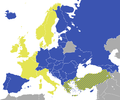
Members Full- Albania
- Andorra
- Armenia
- Austria
- Azerbaijan
- Belgium
- Bosnia and Herzegovina
- Bulgaria
- Croatia
- Cyprus
- Czech Republic
- Denmark
- Estonia
- Finland
- France
- Georgia
- Germany
- Greece
- Hungary
- Iceland
- Ireland
- Italy
- Latvia
- Liechtenstein
- Lithuania
- Luxembourg
- Macedonia1
- Malta
- Moldova
- Monaco
- Montenegro
- Netherlands
- Norway
- Poland
- Portugal
- Romania
- Russia
- San Marino
- Serbia
- Slovakia
- Slovenia
- Spain
- Sweden
- Switzerland
- Turkey
- Ukraine
- United Kingdom
ObserverFormer1 Provisionally referred to by the Council of Europe as "the former Yugoslav Republic of Macedonia"; see Macedonia naming dispute.Member nations Andorra · Angola · Bolivia · Brazil · Cape Verde · Chile · Colombia · Costa Rica · Côte d'Ivoire · Cuba · Dominican Republic · East Timor · Ecuador · El Salvador · France · Guatemala · Guinea-Bissau · Haiti · Honduras · Italy · Mexico · Moldova · Monaco · Mozambique · Nicaragua · Panama · Paraguay · Peru · Philippines · Portugal · Romania · San Marino · São Tomé and Príncipe · Senegal · Spain · Uruguay · VenezuelaPermanent observers Official languages Member states and observers of the Francophonie Members - Albania
- Andorra
- Armenia
- Belgium
- Benin
- Bulgaria
- Burkina Faso
- Burundi
- Cambodia
- Cameroon
- Canada
- Cape Verde
- Central African Republic
- Chad
- Comoros
- Cyprus1
- Democratic Republic of the Congo
- Republic of the Congo
- Côte d'Ivoire
- Djibouti
- Dominica
- Egypt
- Equatorial Guinea
- France
- Gabon
- Ghana1
- Greece
- Guinea
- Guinea-Bissau
- Haiti
- Laos
- Luxembourg
- Lebanon
- Macedonia2
- Madagascar
- Mali
- Mauritania
- Mauritius
- Moldova
- Monaco
- Morocco
- Niger
- Romania
- Rwanda
- St. Lucia
- São Tomé and Príncipe
- Senegal
- Seychelles
- Switzerland
- Togo
- Tunisia
- Vanuatu
- Vietnam
Observers 1 Associate member.
2 Provisionally referred to by the Francophonie as the "former Yugoslav Republic of Macedonia"; see Macedonia naming dispute.Current members Former member Observers Members of the Central European Free Trade Agreement Albania · Bosnia and Herzegovina · Croatia · Kosovo/UNMIK · Macedonia · Moldova · Montenegro · Serbia
Organization of the Black Sea Economic Cooperation (BSEC) Commonwealth of Independent States (CIS) Members 
Associate members Former member - Georgia (1993-2009)
Categories:- Moldova
- European countries
- Member states of La Francophonie
- Member states of the Commonwealth of Independent States
- Landlocked countries
- Republics
- Romanian-speaking countries and territories
- Russian-speaking countries and territories
- States and territories established in 1991
- Ukrainian-speaking countries and territories
- Areas of traditional spread of Ukrainians and Ukrainian language
- Member states of the United Nations
Wikimedia Foundation. 2010.

